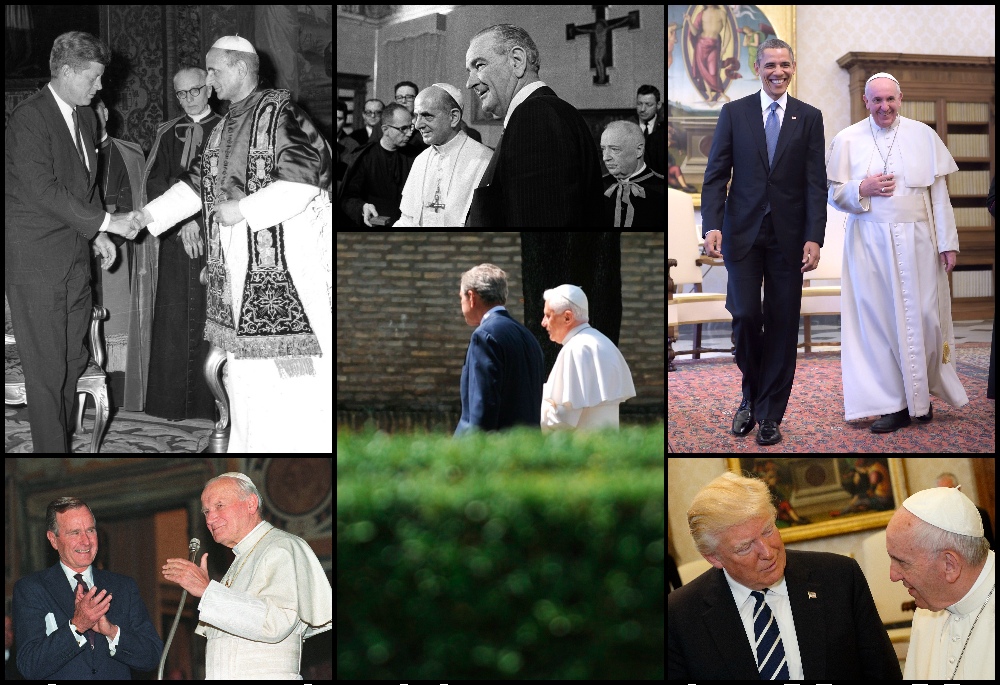
Top row, from left: President John Kennedy and Pope Paul VI in 1963 (CNS file photo); Paul VI and President Lyndon Johnson in 1967 (CNS/LBJ Library/Yoichi Okamoto); President Barack Obama and Pope Francis in 2014 (CNS/Stefano Spaziani, pool). Bottom row, from left: President George H.W. Bush and Pope John Paul II in 1991 (CNS/Reuters/Rick Wilking); President George W. Bush and Pope Benedict XVI in 2008 (CNS/Reuters/Filippo Monteforte); President Donald Trump and Francis in 2017 (CNS/Paul Haring).
When Joe Biden arrives at the Vatican to see Pope Francis on Oct. 29, it will mark the 31st time a pope and a sitting U.S. president have met.
Their meeting, however, will mark only the second time in history that a Catholic U.S. president has been face to face with the pope, coming nearly 60 years after the nation's first Catholic president, John F. Kennedy, met Pope Paul VI in 1963.
This particular meeting between the president and the pope comes less than a month before the U.S. Catholic bishops will vote on a document on the Eucharist, in which some conservative bishops have suggested Biden be denied Communion due to his support for legal abortion. Pope Francis and other Vatican officials have cautioned against such a stance.
Yet despite the buildup and anticipation for this closely watched encounter, at least one former diplomat says that a visit from a head of state is a "routine matter" for the Vatican, which has the oldest diplomatic corps in the world and hosts many such VIP visits every year.
"They have it down to a science," Peter Martin, a former U.S. diplomat at the U.S. Embassy to the Holy See, told NCR.
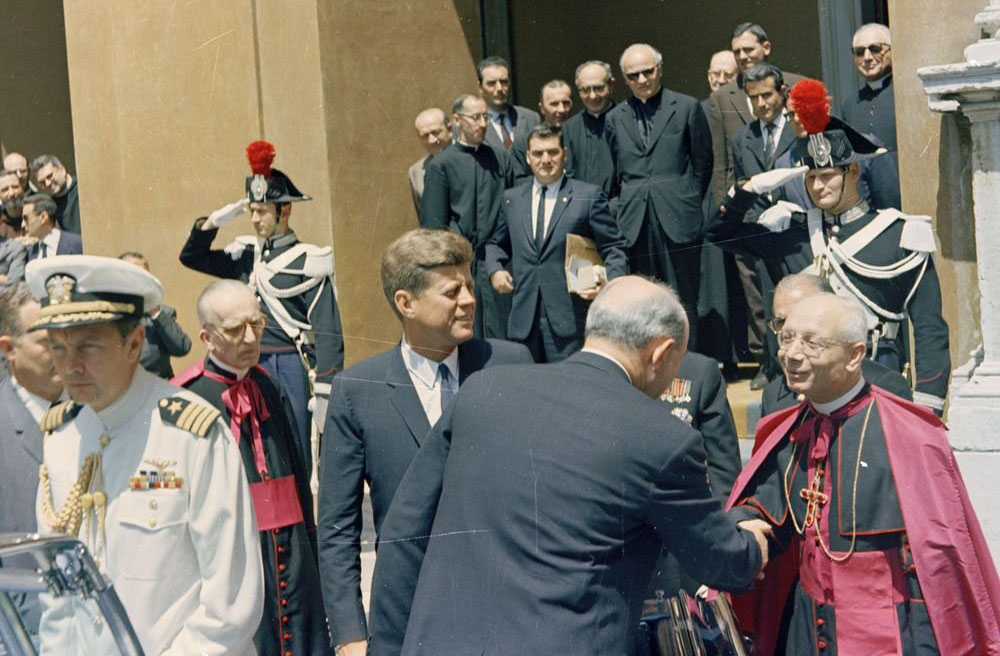
President John F. Kennedy departs after a meeting with Pope Paul VI at the Vatican July 2, 1963. (CNS/John F. Kennedy Presidential Library and Museum, Boston/Cecil Stoughton, White House Photographs)
Jesuit Fr. Thomas Reese, writing in 2014, notes that the Vatican has more than 1,000 years of working with kings, presidents and other heads of state. "Unlike the U.S. Congress, the Vatican knows how to chew gum and walk at the same time," Reese wrote.
"It can disagree with someone on some issues while working cooperatively with them on other issues," Reese continued.
'As seamless as possible'
When the U.S. president goes abroad, he travels with scores of advisers, family members and personal guests, Secret Service and other security officials, along with the traveling press corps — arriving on Air Force One (and a backup) and some 20 vehicles to escort him around town.
It's a stark contrast to Pope Francis, who travels around the Vatican and Rome in a Ford Focus and charters his own plane when he wants to travel.
Everyone involved in pulling off a meeting between the pope and the president has high demands, but, according to Martin, both the world's superpower and the world's smallest state work together genially and efficiently to ensure that such encounters are as seamless as possible.
Having worked on presidential visits under the papacies of John Paul II, Benedict XVI and Francis, Martin told NCR he was consistently "struck at how the Vatican makes a complicated visit look like clockwork."
Martin recalled one such occasion when U.S. Secretary of State John Kerry and Russian Foreign Minister Sergey Lavrov were each due for separate meetings at the Vatican on the same day.
"These are two countries with large footprints and high media interest," he said, "but the Holy See was unfazed and pulled off both visits without a hitch."
Advertisement
Such is likely to be the case over the weekend of Oct. 29, when world leaders from around the globe are due to arrive in Rome for the G-20 and the likes of South Korean President Moon Jae-in and India's Prime Minister Narendra Modi also are expected to meet the pope over the weekend.
In normal years, the Vatican hosts 35-40 heads of state each year, though that number has been dramatically reduced due to the COVID-19 pandemic. On the Vatican side, the major players involved in such visits are the head of protocol, head of the papal household and the Gendarmerie (or security force).
For meetings involving the U.S. president, Martin described it as an "all-embassy effort" that also requires the "close cooperation" among the U.S. Embassy to the Holy See, the U.S. Embassy to Italy and the U.S. Mission to the U.N. Agencies in Rome, along with the White House.
The planning process for such encounters often takes weeks — and many weeks, in some cases — in advance.
One notable exception was the visit of President George W. Bush for the funeral of Pope John Paul II in 2005, where some 200 world leaders arrived at the Vatican. Bush arrived in Rome along with his father, former President George H.W. Bush, and former President Bill Clinton with little lead time for advance planning.
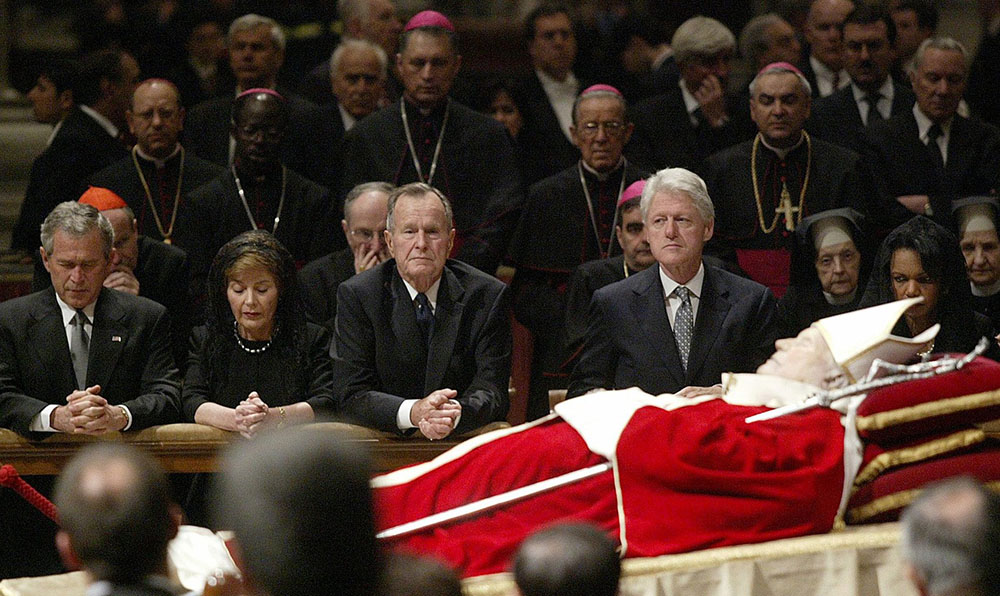
On April 6, 2005, President George W. Bush, first lady Laura Bush and former Presidents George H.W. Bush and Bill Clinton pay respects to Pope John Paul II while viewing the late pontiff's body in St. Peter's Basilica at the Vatican. (CNS/Reuters)
Since former Sen. Joe Donnelly has not yet been confirmed by the U.S. Senate to serve as the new U.S. ambassador to the Vatican, he will not be present in Rome for the meeting. When then-President Donald Trump met Francis in May 2017, his ambassador pick, Callista Gingrich, was not present in Rome either, having only been nominated earlier that month.
"It would be ideal to have [Donnelly] already confirmed and in his seat, but this won't overshadow the visit," Martin said. "Holy See officials understand the delays in confirming new ambassadors that can occur in a new administration."
Martin emphasized the essential role that the chargé d'affaires, currently Patrick Connell, serves in the interim to keep the embassy fully functioning.
"The U.S. chargé d'affaires is an experienced and highly regarded diplomat who will ensure that the embassy does everything needed to support the visit," he said.
Schedules and protocols
On Friday morning, Oct. 29, Biden's escort will bring him across town where traffic on the iconic Via della Conciliazione will be closed off, along with many of the surrounding streets.
Biden and First Lady Jill Biden (both likely dressed in black attire, as is custom) and those accompanying them to the meeting will exit their vehicles in the Vatican's imposing San Damaso Courtyard to the sounds of hundreds of rapid camera shutter clicks and likely reporters yelling out questions to him as he makes his way into the Apostolic Palace, up the elevators to the second floor.
The White House will have carefully crafted the list of names of those that will join the president for an introduction to the pope apart from their one-on-one time.
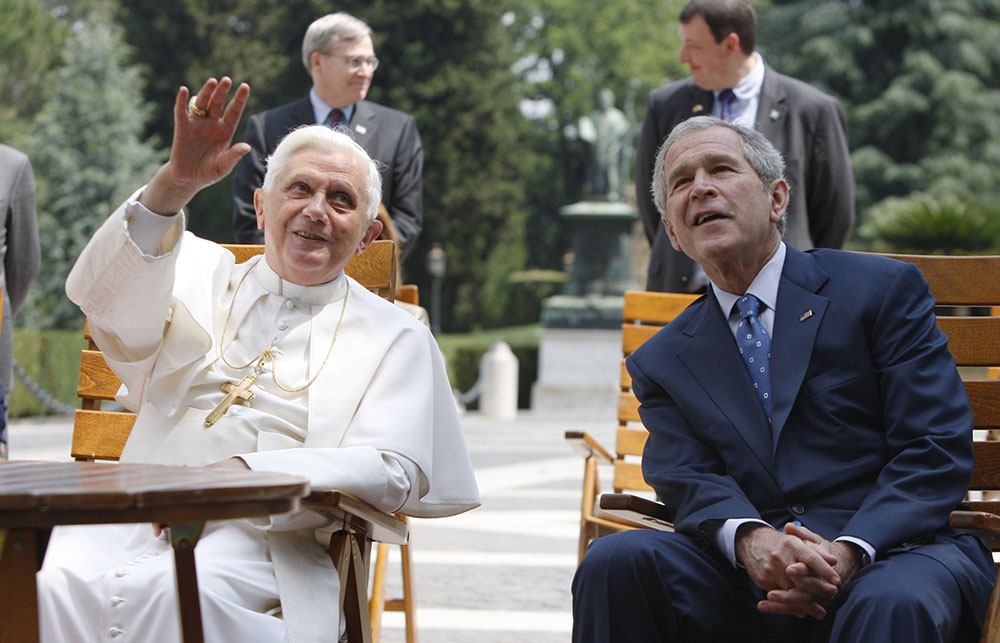
President George W. Bush listens to Pope Benedict XVI during a visit to the Lourdes grotto in the Vatican Gardens June 13, 2008. (CNS/Reuters/Jason Reed)
In 2017, Trump's press secretary Sean Spicer, a practicing Catholic, was noticeably excluded from that entourage as the visit came during a tense period of his relationship with the president.
On that occasion, Trump and Francis met for about 30 minutes alone. In 2014, President Barack Obama's meeting with Francis lasted 52 minutes, and, in 2007, when George W. Bush met with Pope Benedict XVI, their meeting also lasted about an hour.
The two parties will exchange gifts, which has recently included copies of the World Day of Peace message and the Document on Human Fraternity from the pontiff's end. The president's gifts to the pope will have been carefully decided after likely conversations with Catholic allies of the president, and it's a safe bet that it will probably be less self-referential than President Lyndon Johnson's silver-framed autographed photo of himself that he presented Paul VI in 1965.
An often-overlooked part of a president's time at the Vatican is the meeting between the president and the Vatican's secretary of state, now Cardinal Pietro Parolin, in which the parties get into specific issues of policy interest to the Holy See and the United States.
Typically, Archbishop Paul Gallagher, the Vatican's foreign minister, is also present for such a meeting, which takes place on the first floor of the Apostolic Palace.
Martin described Parolin and Gallagher as "consummate diplomats who understand world affairs" and said that such a meeting is a "great opportunity for both sides" to better understand each other.
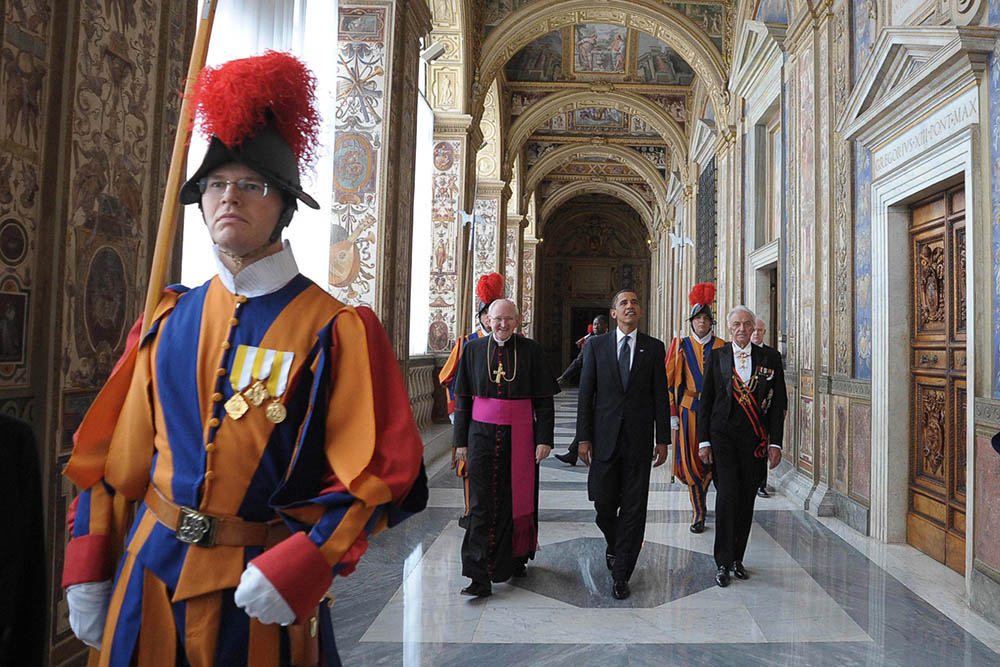
Swiss Guards and Vatican officials accompany President Barack Obama as he arrives for his meeting with Pope Benedict XVI at the Vatican July 10, 2009. (CNS/L'Osservatore Romano via Reuters)
In recalling the meeting with Bush and the Vatican's secretary of state, former U.S. Ambassador to the Vatican Francis Rooney told C-SPAN that there was discussion of activities in 16 different countries where the Holy See and the United States are aligned.
"The briefing for the president would have involved a wide range of geographical locations where freedoms are at risk, human rights are at risk, and where the United States and the Holy See can work together, as well as a few areas where the United States and the Holy See part company," he recalled.
At the conclusion of the meetings, both the Vatican and the White House will release brief summary readouts of the conversations.
Those expecting commentary on the abortion and Communion debates roiling back at home in the United States or any other juicy tidbits may likely be disappointed, as the Vatican template tends to emphasize areas of common commitments, rather than disagreements.
"Even though the pontificates differ," Martin observed, "the visits typically play out in a very similar way."








